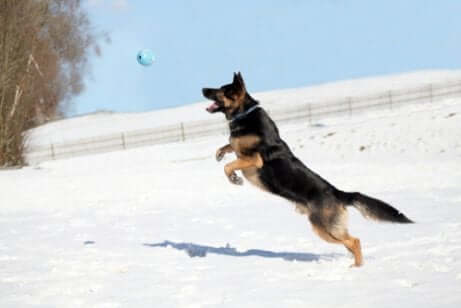Animal Osteopathy: What Is It and What Does It Treat?


Written and verified by the lawyer Francisco María García
Currently, animal osteopathy is becoming increasingly popular for treating problems with mobility. It’s one of the most sophisticated and effective physiotherapeutic disciplines in veterinary medicine. This is because it can treat a wide range of diseases and optimize bone-muscle rehabilitation.
Next, we’ll explain what animal osteopathy is and what it can be used for in the context of veterinary medicine for horses, dogs, cats, and other pets.
What is animal osteopathy?
Animal osteopathy is a branch of veterinary medicine that studies the capacity of the body to self-regenerate and self-correct. It focuses on the evaluation and treatment of motor dysfunctions that lead to health problems and affect the patient’s quality of life.
Mobility is the key concept of osteopathic science. Practitioners believe that the ability to move freely and independently affects the quality of life, health, and the autonomy of the individual.
In other words, osteopaths understand that loss of mobility, either total or partial, can lead to an imbalance in the body. As a result, not just the region in pain is affected. The entire body of the patient is affected since it can create altercations in their behavior or emotional damage.

In practice, animal osteopathy consists of a wide range of non-invasive techniques. Most of them are manual. The main objective is to stimulate the self-correction of body tissues to recover normal mobility.
This is an alternative treatment that doesn’t usually use drugs or chemicals to relieve ailments. For this reason, it’s necessary to look for veterinarians trained in animal osteopathy to treat our pet.
Osteopaths should be, first of all, trained veterinarians. They should have training in this physiotherapeutic discipline. Any professional that is performing any type of therapy or alternative medicine should have extensive prior training.
When is animal osteopathy recommended?
As we’ve mentioned, animal osteopathy deals with a wide range of health problems that can lead to a partial or total loss of mobility. Its application can also go beyond treating or alleviating the symptoms of diseases, congenital conditions, and traumas. It’s very effective in relieving pain, providing comfort, and encouraging the regeneration of damaged tissues.
Osteopathic practices are also recommended to prevent degenerative diseases, especially those that affect the animal’s bones and muscles. In dogs predisposed to hip dysplasia, such as the German shepherd, osteopathy can help control the degenerative process and delay the development of symptoms.

Preventive osteopathy can greatly benefit active animals or ones who do high-performance activities. In addition to helping prevent injuries, it also helps improve performance and helps prevent overexertion, contractions, and muscle spasms.
On the other hand, osteopathy is also usually the most viable and safe alternative to an inconclusive diagnosis. In other words, when a veterinarian can’t give a certain diagnosis through physical tests and examinations, osteopathy is another option for dealing with mobility issues.
What diseases can be treated?
As we’ve seen, animal osteopathy is a discipline of veterinary medicine, which treats diseases such as:
- Locomotor dysfunctions, such as lameness, cramps, muscle weakness, spinal pain, etc.
- Musculoskeletal degenerative diseases, such as hip and elbow dysplasia.
- Digestive disorders: diarrhea, vomiting, gastritis, among others.
- Problems in the urinary tract, such as urinary tract infections, kidney failure, urinary incontinence, etc.
- Difficulty with allergies or respiratory problems.
- Rashes and skin diseases.
- Neurological disturbances, such as epilepsy.
- Persistent otitis.
- Rehabilitation of traumas, accidents, and surgery
Animal osteopathy to treat behavioral problems
Animal osteopathy can also help in the treatment and prevention of behavioral problems. This is because these practices can help prevent diseases and hormonal disturbances which negatively impact their behavior.
On the other hand, osteopathy is effective to relieve symptoms of stress, boredom, hyperactivity, nervousness and excessive fear. It creates a feeling of well-being and can improve the animal’s self-confidence. Experts are evaluating the effectiveness of this treatment for a variety of animals.
All cited sources were thoroughly reviewed by our team to ensure their quality, reliability, currency, and validity. The bibliography of this article was considered reliable and of academic or scientific accuracy.
- Diego Mas. Equibalance. Osteopatía en caballos. Extraído de: http://www.equibalance.es/articulos/Salud/OSTEOPATIA%20EN%20CABALLOS.pdf
- ]. Rueda Hernánz, A.L.FernándezSana. Osteodistrofias en el perro y en el gato. Diagnóstico diferencial. Extraído de: https://ddd.uab.cat/pub/clivetpeqani/11307064v9n1/11307064v9n1p1.pdf
This text is provided for informational purposes only and does not replace consultation with a professional. If in doubt, consult your specialist.